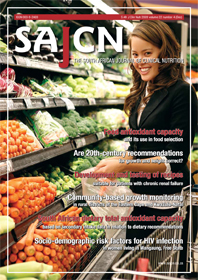Food Antioxidant Capacity and its Use in Food Selection
Keywords:
food antioxidant capacity
Abstract
In the current issue of the Journal, Louwrens and co-workers determine the per capita South African daily dietary total antioxidant capacity (TAC)1 using published data by Nel and Steyn (2002) which summarises the food consumption studies conducted in SA from 1983–2000. The data reflect the daily per capita intake of food and beverages as based on those foods and beverages consumed by more than 3% of South African adults of all ages and ethnic groups.2 Using this dietary data, they calculate the Total Antioxidant Capacity (TAC) using the Oxygen Radical Absorbance Capacity (ORAC) values for the closest matching foods as reported by the United States Department of Agriculture (compiled for typical foods available in the US).3 For foods not found in the USDA (US Department of Agriculture) ORAC database and for which no equivalents could be found, ORAC analyses were done (for the hydrophilic chain breaking antioxidant capacity only). The authors report TAC values ranging from as low as 7 635 µmoles Trolox Equivalents (TE) (for the Lebowa study) to 15 934 µmoles TE (for the CORIS study) and an average of 11 433 µmoles TE for all the 11 studies summarised. The authors conclude that a TAC of 20 513 µmoles TE per person per day is the recommended TAC objective (based on a diet compiled using the five-a-day concept) and that diet choices should be made with this in mind. Due to the fact that the estimated South African dietary TAC, as calculated from the secondary data published by Nel and Steyn, is 11 433 µmoles TE, the authors further conclude that the average estimated adult South African dietary TAC is only about half of what it should be.1
Published
2009-11-11
How to Cite
Loots, D. T. (2009). Food Antioxidant Capacity and its Use in Food Selection. South African Journal of Clinical Nutrition, 22(4), 169. Retrieved from http://sajcn.redbricklibrary.com/index.php/SAJCN/article/view/378
Issue
Section
Editorial
Material submitted for publication in the South African Journal of Clinical Nutrition (SAJCN) is accepted provided it has not been published elsewhere. Copyright forms will be sent with acknowledgement of receipt and the SAJCN reserves copyright of the material published.
The SAJCN does not hold itself responsible for statements made by the authors.


